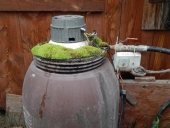Jonathan Hopkins wrote: Alright, with that being said, I've been formulating an idea for the past few weeks about an in house pico-hydro small electric generator power plant. The idea starts with a 55 gallon drum filled with water. At the bottom of the drum is a 3/4" hole with a valve. After the valve a hose would run to a water pump inlet. A hose would then be ran from the outlet of the pump to a 1/2" nozzle, or two, which would be directed at a pelton wheel. The pelton wheel would be attached to a pma generator directly at the shaft, or through a pulley system. The water would then fall to the bottom of the pelton wheel housing and out a tube that would be redirected into the 55 gallon drum, thus recycling the water and completing the system.
I concur with Tom. It absolutely will not work. However, I think it's important for you to understand how it doesn't work.
All of the energy you have to work with here is gravitational. Specifically, it is gravity acting on the mass of water contained in the drum. This is otherwise known as the "weight" of the water. However, weight (a force) is not energy. Applying a force over a distance IS energy. Actually, it's more useful to consider that a force acting over a distance TRANSFERS energy at a rate that can be quantified by the product of the applied force and the displacement over which the force is applied in that same direction. With water contained in a drum, it doesn't matter whether or not we suspend the drum with a rope connected to a pulley, connect the pulley to an alternator, then allow the drum to fall ten feet all the while driving the alternator to make electricity.... OR, if we allow the water to drain out of the drum down and through a line ten feet below to a pelton wheel that is connected to an alternator. The principle is the same. The weight of the water (a force) falls a distance of ten feet in the same direction at which that force (the weight) is directed. Now, you're proposing that the system essentially regenerate itself. This is just like connecting one drum filled with water to an identical drum filled with water through a pulley system that also drives an alternator. Once the two drums are at the same level, then there is no net force on the pulley and the system stops. No net energy. In the context of your system, you drain an inch of water from the drop of the drum through the pelton wheel (no different than dropping the drum by an inch) which delivers energy to the ouput shaft of the pelton wheel. Now, to return the water to the drum you have to raise the water level by one inch to maintain equilibrium (this is just like raising the drum of water by one inch). Of
course, this means ALL the energy delivered by the pelton wheel shaft is used to drive the pump use to return the water. In reality, due to friction and other losses, the pelton wheel cannot return all the water to the drum let alone provide any NET energy out.
Think of it this way. You have a two pulleys. One is 100 feet above the other and they are connected by a long belt such that when one turns the other also turns. A shaft is connected to the lower pulley such that it drives an alternator. Let's say you have heavy weight that can be attached to the rope, and this weight is located at the top pulley. A person clamps the weight onto the rope and the weight falls. This pulls on the pulleys to cause a torque that turns the alternator. Now, once the weight falls to the lower pulley, then the motion stops. There is no more energy available for the system. The only way to return the system back to the initial state is to raise the weight back up to the top pulley. However, this requires one to expend at least as much energy that the falling weight delivered. The same principle applies with multiple weights, or with a mass of water (which consists of trillions of little molecular weights).
Returning the water from the pelton wheel housing and back to the drum requires the delivery of at least the same amount of energy that is delivered to the pelton wheel when that same mass of water flowed through the pelton wheel. There can be no net energy delivered if one stipulates that the system remain in equilibrium (i.e. that the water level in the drum not fall, assuming the water is not replenished from an outside source).













 1
1



































